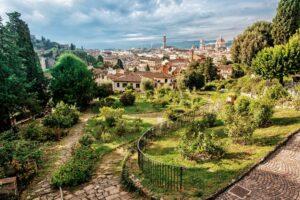Fodor's Expert Review Santo Spirito
The plain, unfinished facade belies and interior that is one of the most important examples of Renaissance architecture in Italy. It's one of a pair designed in Florence by Filippo Brunelleschi in the early decades of the 15th century (the other is San Lorenzo). It was here that Brunelleschi supplied definitive solutions to the two major problems of interior Renaissance church design: how to build a cross-shape interior using classical architectural elements borrowed from antiquity and how to reflect in that interior the order and regularity that Renaissance scientists (among them Brunelleschi himself) were at the time discovering in the natural world around them.
Brunelleschi's solution to the first problem was brilliantly simple: turn a Greek temple inside out. While ancient Greek temples were walled buildings surrounded by classical colonnades, Brunelleschi's churches were classical arcades surrounded by walled buildings. This brilliant architectural idea overthrew the previous... READ MORE
The plain, unfinished facade belies and interior that is one of the most important examples of Renaissance architecture in Italy. It's one of a pair designed in Florence by Filippo Brunelleschi in the early decades of the 15th century (the other is San Lorenzo). It was here that Brunelleschi supplied definitive solutions to the two major problems of interior Renaissance church design: how to build a cross-shape interior using classical architectural elements borrowed from antiquity and how to reflect in that interior the order and regularity that Renaissance scientists (among them Brunelleschi himself) were at the time discovering in the natural world around them.
Brunelleschi's solution to the first problem was brilliantly simple: turn a Greek temple inside out. While ancient Greek temples were walled buildings surrounded by classical colonnades, Brunelleschi's churches were classical arcades surrounded by walled buildings. This brilliant architectural idea overthrew the previous era's religious taboo against pagan architecture once and for all, triumphantly claiming that architecture for Christian use.
Brunelleschi's solution to the second problem—making the entire interior orderly and regular—was mathematically precise: he designed the ground plan of the church so that all its parts were proportionally related. The transepts and nave have exactly the same width; the side aisles are precisely half as wide as the nave; the little chapels off the side aisles are exactly half as deep as the side aisles; the chancel and transepts are exactly one-eighth the depth of the nave; and so on, with dizzying exactitude. For Brunelleschi, such a design technique was a matter of passionate conviction. Like most theoreticians of his day, he believed that mathematical regularity and aesthetic beauty were flip sides of the same coin, that one was not possible without the other. In the refectory, adjacent to the church, you can see Andrea Orcagna's highly damaged fresco of the Crucifixion.
READ LESS







